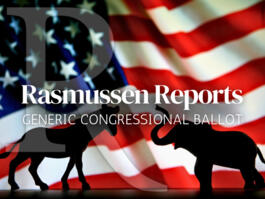Are Voters More Secretive About Their Ballot This Year?
Democrats are more likely than Republicans and unaffiliated voters to boast about how they are going to vote in the upcoming congressional midterm elections.
A new Rasmussen Reports national telephone and online survey finds that 51% of Likely Democratic Voters are more likely to let others know how they intend to vote this year compared to previous congressional elections. This compares to 46% of Republicans and just 32% of voters not affiliated with either major political party.
Eleven percent (11%) of Democrats, 10% of GOP voters and 12% of unaffiliateds are less likely to tell others how they are going to vote this year. One-in-three Democrats (34%), 41% of Republicans and 49% of unaffiliated voters say they feel about the same as any other election year. (To see survey question wording, click here.)
When asked about their family, friends and co-workers, Democrats (47%) believe more strongly than Republicans (41%) and unaffiliated voters (34%) that they, too, are more likely to tell others how they plan to vote. Unaffiliated voters are the most likely to be undecided.
Among all likely voters, 44% are more likely this year to let others know how they intend to vote; 11% are less likely to do so, and 41% feel about the same as they have in past election years.
Democrats continue to hold a slight lead over Republicans on the Rasmussen Reports Generic Congressional Ballot, although that lead has narrowed since the beginning of the year.
(Want a free daily e-mail update? If it's in the news, it's in our polls). Rasmussen Reports updates are also available on Twitter or Facebook.
The survey of 1,000 Likely Voters was conducted on April 30-May 1, 2018 by Rasmussen Reports. The margin of sampling error is +/- 3 percentage points with a 95% level of confidence. Field work for all Rasmussen Reports surveys is conducted by Pulse Opinion Research, LLC. See methodology.
Some suggested during the 2016 presidential campaign that Donald Trump had hidden support among voters who were unwilling to say publicly where they stood because they were fearful of criticism. Republicans were clearly more reluctant than Democrats in an August 2016 survey to say how they were going to vote, and most pollsters missed Trump's surprise victory.
Most voters don't believe political polls, although Democrats express more confidence in them than others do.
Men are more likely than women to tell others how they plan to vote this year. Middle-aged voters are more inclined than others to see this year as the same as other congressional elections.
Other minority voters are much more likely than whites and blacks to say how they will vote.
Fifty-seven percent (57%) of voters who Strongly Approve of the job Trump is doing are more likely to tell others how they intend to vote for Congress. Among those who Strongly Disapprove of the president’s job performance, 47% are more likely to say publicly how they’re going to vote.
Voters have less faith in polls than they do in current news reporting on politics, even though a new high of 54% says they don't trust the political news they are getting.
Voters see a more divided America since Trump was elected president, but they don't put all the blame on him. Forty-five percent (45%) say the president is more to blame than his political opponents for the division in America. Nearly as many (40%), however, feel his opponents are to blame.
Most Republicans continue to think voters in their party are moving away from the GOP leadership ideologically. For Democrats, their leadership is a better fit these days. Republicans remain much more likely to agree with Trump politically than with the average GOP member of Congress.
The emergence of a new breed of RINOs (Republicans in Name Only) who are identifying less and less with the party’s traditional leadership could be a problem for Republicans in the upcoming midterm congressional elections.
Additional information from this survey and a full demographic breakdown are available to Platinum Members only.
Please sign up for the Rasmussen Reports daily e-mail update (it’s free) or follow us on Twitter or Facebook. Let us keep you up to date with the latest public opinion news.
The survey of 1,000 Likely Voters was conducted on April 30-May 1, 2018 by Rasmussen Reports. The margin of sampling error is +/- 3 percentage points with a 95% level of confidence. Field work for all Rasmussen Reports surveys is conducted by Pulse Opinion Research, LLC. See methodology.
Rasmussen Reports is a media company specializing in the collection, publication and distribution of public opinion information.
We conduct public opinion polls on a variety of topics to inform our audience on events in the news and other topics of interest. To ensure editorial control and independence, we pay for the polls ourselves and generate revenue through the sale of subscriptions, sponsorships, and advertising. Nightly polling on politics, business and lifestyle topics provides the content to update the Rasmussen Reports web site many times each day. If it's in the news, it's in our polls. Additionally, the data drives a daily update newsletter and various media outlets across the country.
Some information, including the Rasmussen Reports daily Presidential Tracking Poll and commentaries are available for free to the general public. Subscriptions are available for $4.95 a month or 34.95 a year that provide subscribers with exclusive access to more than 20 stories per week on upcoming elections, consumer confidence, and issues that affect us all. For those who are really into the numbers, Platinum Members can review demographic crosstabs and a full history of our data.
To learn more about our methodology, click here.





